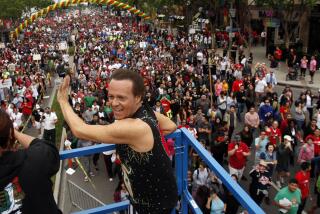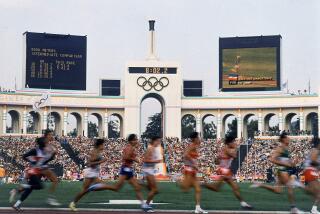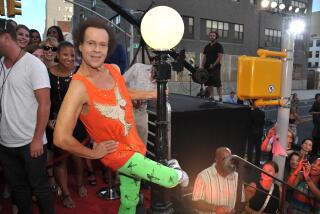Larry Scott dies at 75; champion bodybuilder
Larry Scott wasnât exactly a 98-pound weakling â he weighed in at 120 â but his life changed forever after he ran across a stack of bodybuilding magazines in an Idaho city dump.
The scrawny 16-year-old started working out in private, doing lifts with a tractor axle.
Within 10 years, he was Mr. Idaho, Mr. California, Mr. Pacific Coast, Mr. America and Mr. Universe.
In 1965, he became the worldâs first Mr. Olympia, a title designed by promoter and publisher Joe Weider as bodybuildingâs indisputably supreme honor.
The outcome âwas more or less decided the first time the judges got a look at Larry Scottâs biceps,â Weider later wrote in his Muscle & Fitness magazine. âThose mountainous, cannonball-like peaks were different from anything the sport had ever seen.â
Scott, who was nicknamed âThe Legendâ and was on Weiderâs list of âthe 20 greatest physiques the world has ever known,â died Saturday in Salt Lake City from complications of Alzheimerâs disease, his family said. He was 75.
In a Twitter message, former Gov. Arnold Schwarzenegger, who also had a place on Weiderâs â20 greatestâ list, called Scott âa great man who inspired millions.â
When he was 28 in 1966, Scott snagged his second Mr. Olympia title and stunned the bodybuilding world by announcing his retirement. Like boxer Rocky Marciano, one of his heroes, he said he wanted to go out on top.
But years later, he also said he had been haunted for some time by doubts about the lure of celebrity and his quest for physical perfection.
After the 1962 Mr. America competition, he stared mercilessly into a hotel room mirror.
âI saw an athlete whoâd achieved outward perfection: tanned, muscular, seemingly confident and charming â and he was spiritually dead,â he told writer Rod Labbe in an interview for Iron Man magazine.
âMy dreams â what Iâd once thought so important â meant nothing,â Scott said. âBut what could I do? I was Mr. America and had to set a good example.â
Ultimately, Scott said, he found solace in his familyâs Mormon beliefs. After his bodybuilding career, he owned gyms and a Utah business selling bodybuilding equipment, training programs and nutritional supplements.
Born in Blackfoot, Idaho, on Oct. 12, 1938, Larry Dee Scott took courses in sports officiating at Idaho State University but was unenthusiastic. Spotting a matchbook ad for an electrical engineering course at a Los Angeles trade school, he talked his parents into letting him go.
California âwas simply the place to be,â he told Iron Man. âThey had great gyms there, and I wanted to bring my development to the next level.â
In 1964, Scott made his only foray into movies in âMuscle Beach Party,â starring Annette Funicello and Frankie Avalon. He was Rock, one of the muscle men coached by Jack Fanny, a gym owner played by Don Rickles.
In real life, Scott worked out with celebrated trainer Vince Gironda at his North Hollywood gym. He drank a gallon of milk daily, ate lots of eggs and took protein supplements. At full strength, he had âpectorals that looked like hindquarters on a thoroughbred,â according to the Salt Lake Tribune.
Scott, who wrote a 1992 memoir called âLoaded Guns,â developed biceps 20 inches around â half again as big as the average manâs. He did so many âpreacher curlsâ â a biceps-building exercise on a slanted bench that looks like a pulpit â that they also became known as Scott curls.
One of Scottâs first competitions was for Mr. Idaho in 1959. He was one of eight men competing on a movie theater stage.
âIn those days bodybuilding contests were far from the norm,â he said. âNo red-blooded American male would be caught dead wearing oil and a pair of skimpy underpants and posing.â
Just six years later, the scene at the Brooklyn Academy of Music, site of the first Mr. Olympia competition, was strikingly different, according to an account by bodybuilder Dave Draper.
Backstage, he wrote, the men âgreedily and anxiously pumped up, panted, ghost-posed, sweated, applied oil, sipped water, encouraged, feared and rooted for each other and longed to be somewhere else.â
âI oiled his back, he oiled mine,â Draper, a former Mr. America and Mr. Universe, wrote of Scott. âI said he looked great, he assured me likewise.... A bond is established, lions in a cage, horses before the starting gun, haunted marionettes, their strings slack before manipulation.â
The winners were announced, Draper wrote, to a ârolling thunder never before expressed in this tarnished and fading opera house ⌠an awesome rumble that stopped the heart.â
Scott too could rhapsodize about his sport.
âBodybuilding is like hearing a symphony,â he told the Salt Lake Tribune in 1979. âThe more you hear, the more you know, the more you enjoy. To see and appreciate a beautiful male body at its peak takes education.â
Scottâs survivors include Rachel, his wife since 1966; daughter Susan; sons Erin and Nathan; and seven grandchildren. Two sons died in the 1990s â Derek in a 1992 motorcycle accident and Michael the following year.
More to Read
Start your day right
Sign up for Essential California for the L.A. Times biggest news, features and recommendations in your inbox six days a week.
You may occasionally receive promotional content from the Los Angeles Times.







